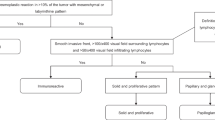Abstract
Background and Purpose
This study was aimed at using proximity ligation assay (PLA) followed by enzyme-linked immunosorbent assay (ELISA) to identify serum biomarkers that predict treatment response and survival for patients with esophageal squamous cell carcinoma (ESCC) undergoing neoadjuvant concurrent chemoradiotherapy (CCRT) followed by esophagectomy.
Methods
Seventy-nine patients with ESCC receiving CCRT of taxane-based/5-fluorouracil-based chemotherapy and 40 Gy followed by surgery were enrolled. Serum samples were collected before and <1 month after CCRT. Fifteen biomarkers were analyzed using PLA. Biomarkers significantly correlating with pathological response/survival were verified by ELISA. Associations of the serum level of biomarkers and clinical factors with pathological response, disease-free survival (DFS), and overall survival (OS) were evaluated by analysis of variance and log-rank tests.
Results
Thirty patients had complete response (38 %), 37 had microscopic residual disease (47 %), and 12 had macroscopic residual disease (15 %). With a median follow-up of 52.8 months, the median DFS was 43 months. Among the 15 biomarkers screened by PLA, vascular endothelial growth factor (VEGF)-A and transforming growth factor (TGF)-β1 were significantly associated with pathological response and/or DFS. These biomarkers were further analyzed by ELISA to confirm initial biomarker findings by PLA. After ELISA of these two markers, only VEGF-A levels were significantly correlated with pathological response. On multivariate analysis, patients with combined high pre-CCRT VEGF-A and TGF-β1 levels (greater than or equal to the median), independent of pathological response, had significantly worse DFS (11 months vs. median not reached; p = 0.007) and OS (16 vs. 46 months; p = 0.07).
Conclusions
Pre-CCRT serum VEGF-A and TGF-β1 levels may be used to predict pathological response and survivals for ESCC patients receiving combined-modality therapy.


Similar content being viewed by others
References
Ferlay J, Shin HR, Bray F, Forman D, Mathers C, Parkin DM. Estimates of worldwide burden of cancer in 2008: GLOBOCAN 2008. Int J Cancer. 2010;127:2893–917.
Merkow RP, Bilimoria KY, McCarter MD, Chow WB, Ko CY, Bentrem DJ. Use of multimodality neoadjuvant therapy for esophageal cancer in the United States: assessment of 987 hospitals. Ann Surg Oncol. 2012;19:357–64.
van Hagen P, Hulshof MC, van Lanschot JJ, et al. Preoperative chemoradiotherapy for esophageal or junctional cancer. N Engl J Med. 2012;366:2074–84.
Hsu FM, Lee JM, Huang PM, et al. Retrospective analysis of outcome differences in preoperative concurrent chemoradiation with or without elective nodal irradiation for esophageal squamous cell carcinoma. Int J Radiat Oncol Biol Phys. 2011;81:e593–9.
Jayachandran P, Pai RK, Quon A, et al. Postchemoradiotherapy positron emission tomography predicts pathologic response and survival in patients with esophageal cancer. Int J Radiat Oncol Biol Phys. 2012;84:471–7.
Owaki T, Matsumoto M, Okumura H, et al. Endoscopic ultrasonography is useful for monitoring the tumor response of neoadjuvant chemoradiation therapy in esophageal squamous cell carcinoma. Am J Surg. 2012;203:191–7.
Luthra R, Luthra MG, Izzo J, et al. Biomarkers of response to preoperative chemoradiation in esophageal cancers. Semin Oncol. 2006;33:S2-5.
Maher SG, Gillham CM, Duggan SP, et al. Gene expression analysis of diagnostic biopsies predicts pathological response to neoadjuvant chemoradiotherapy of esophageal cancer. Ann Surg. 2009;250:729–37.
Fredriksson S, Dixon W, Ji H, Koong AC, Mindrinos M, Davis RW. Multiplexed protein detection by proximity ligation for cancer biomarker validation. Nat Methods. 2007;4:327–9.
Fredriksson S, Horecka J, Brustugun OT, et al. Multiplexed proximity ligation assays to profile putative plasma biomarkers relevant to pancreatic and ovarian cancer. Clin Chem. 2008;54:582–9.
Chang ST, Zahn JM, Horecka J, et al. Identification of a biomarker panel using a multiplex proximity ligation assay improves accuracy of pancreatic cancer diagnosis. J Transl Med. 2009;7:105.
Rice TW, Blackstone EH, Rusch VW. 7th edition of the AJCC Cancer Staging Manual: esophagus and esophagogastric junction. Ann Surg Oncol. 2010;17:1721–4.
Hsu FM, Lee YC, Lee JM, et al. Association of clinical and dosimetric factors with postoperative pulmonary complications in esophageal cancer patients receiving intensity-modulated radiation therapy and concurrent chemotherapy followed by thoracic esophagectomy. Ann Surg Oncol. 2009;16:1669–77.
Gannett DE, Wolf RF, Takahashi GW, et al. Neoadjuvant chemoradiotherapy for esophageal cancer using weekly paclitaxel and carboplatin plus infusional 5-fluorouracil. Gastrointest Cancer Res. 2007;1:132–8.
Shimada H, Takeda A, Nabeya Y, et al. Clinical significance of serum vascular endothelial growth factor in esophageal squamous cell carcinoma. Cancer. 2001;92:663–9.
Kleespies A, Guba M, Jauch KW, Bruns CJ. Vascular endothelial growth factor in esophageal cancer. J Surg Oncol. 2004;87:95–104.
Sun SP, Jin YN, Yang HP, Wei Y, Dong Z. Serum transforming growth factor-beta1 level reflects disease status in patients with esophageal carcinoma after radiotherapy. World J Gastroenterol. 2007;13:5267–72.
McDonnell CO, Harmey JH, Bouchier-Hayes DJ, Walsh TN. Effect of multimodality therapy on circulating vascular endothelial growth factor levels in patients with oesophageal cancer. Br J Surg. 2001;88:1105–9.
Kashyap MK, Harsha HC, Renuse S, et al. SILAC-based quantitative proteomic approach to identify potential biomarkers from the esophageal squamous cell carcinoma secretome. Cancer Biol Ther. 2010;10:796–810.
Noma K, Smalley KS, Lioni M, et al. The essential role of fibroblasts in esophageal squamous cell carcinoma-induced angiogenesis. Gastroenterology. 2008;134:1981–93.
Gholamin M, Moaven O, Memar B, et al. Overexpression and interactions of interleukin-10, transforming growth factor beta, and vascular endothelial growth factor in esophageal squamous cell carcinoma. World J Surg. 2009;33:1439–45.
Disclosures
Jason Chia-Hsien Cheng, Madeline S. Graber, Feng-Ming Hsu, Chiao-Ling Tsai, Leon Castaneda, Jang-Ming Lee, Daniel T. Chang, and Albert C. Koong declare no conflicts of interest or financial disclosures. This work was supported by National Science Council, Taiwan, ROC.
Author information
Authors and Affiliations
Corresponding author
Additional information
Jason Chia-Hsien Cheng and Madeline S. Graber contributed equally to this work.
Electronic supplementary material
Below is the link to the electronic supplementary material.
Rights and permissions
About this article
Cite this article
Cheng, J.CH., Graber, M.S., Hsu, FM. et al. High Serum Levels of Vascular Endothelial Growth Factor-A and Transforming Growth Factor-β1 Before Neoadjuvant Chemoradiotherapy Predict Poor Outcomes in Patients with Esophageal Squamous Cell Carcinoma Receiving Combined Modality Therapy. Ann Surg Oncol 21, 2361–2368 (2014). https://doi.org/10.1245/s10434-014-3611-z
Received:
Published:
Issue Date:
DOI: https://doi.org/10.1245/s10434-014-3611-z




